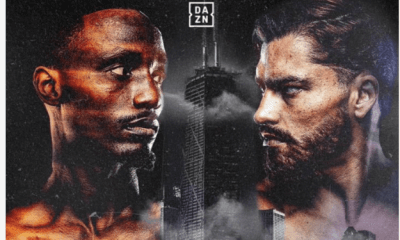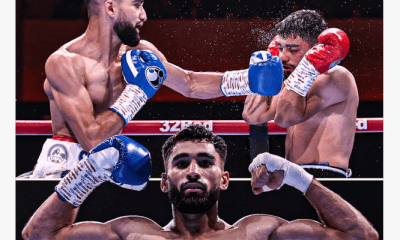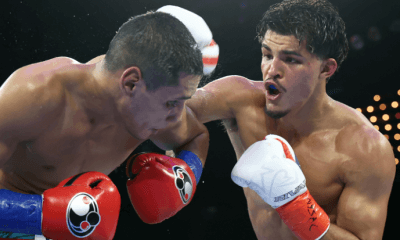Featured Articles
A Ray to Remember

Monday, April 6, marks the 33rd anniversary of the storied fight between Sugar Ray Leonard and Marvin Hagler. In 2007, in conjunction with the 20th anniversary, Philadelphia Daily News boxing writer Bernard Fernandez looked back at that event through the eyes of Sugar Ray Leonard with whom he had arranged an exclusive interview. Fernandez’s feature-length story ran under the title “A Ray to Remember.”
With Bernard’s permission, we are re-printing that story in its entirety. A 2020 International Boxing Hall of Fame inductee, the multi-decorated Fernandez is the author of “Championship Rounds,” a soon-to-be-published anthology.
A Ray to Remember
The image is one of eternal youth, the impossibly gifted and charismatic young father smiling and cutting up with his giggling tyke of a son.
But the popular soft-drink commercial in which Ray Leonard Sr. and Ray Jr. appeared together aired in 1980, when certain boxers, if not boxing itself, were still seen as having broad enough appeal to sell products to America.
The 2007 vintage Ray Leonard Sr., better known to his many fans as Sugar Ray, remains handsome and charismatic. But, at 50, his working attire now runs more toward tailored suits and tasseled, Italian-made loafers than to satin trunks and tasseled boxing shoes. It has been more than 10 years since he attempted to summon the old magic in a final, futile comeback bid.
But during a luminescent prime in which he transcended his sport as few have, the quick-handed, steel-willed kid from suburban Washington, D.C., gave the public more than a few moments that are indelibly burned into the pages of boxing history. There was the gold medal he won at the 1976 Montreal Olympics; his stirring, late-round comeback in his first showdown with Thomas Hearns; the night he so dominated the great Roberto Duran in their first rematch that the “Hands of Stone” up and quit in the eighth round.
For all those peaks in a Himalayan career, however, perhaps the most towering accomplishment occurred on April 6, 1987, in a temporary outdoor stadium erected on the tennis courts at Caesars Palace in Las Vegas. That’s when Leonard emerged from one of several retirements to shock undisputed middleweight champion Marvelous Marvin Hagler, who was widely regarded as near-invincible. In the Vegas sports books, the odds against Leonard were incredibly long for someone of his stature. More than a few members of the media even expressed concern for his immediate and long-term health.
Today is the 20th anniversary of Hagler-Leonard, a prizefight that seized the attention of the entire world, but the years always melt away in the mind of the man who manufactured one of boxing’s most unforgettable upsets. All Leonard has to do is close his eyes for the memories to come flooding back, as warm and vivid as ever.
“I swear, I look at my kids and wonder where the time went,” Leonard said in an exclusive interview with the Daily News recently. “Can it really have been 20 years? One day, you look at your son and he’s a little boy. Before you know it, he’s sprouting facial hair and is three or four inches taller than you. You’re, like, `Wow.’ Ray Jr. is 33 now.
“It’s funny how the good memories stick with you longer. Human nature, I suppose. I could always tell in the dressing room, when I was warming up, if it was going to be a good night or a long night. If you don’t feel like you have it that night, it is the most frightening thing for a fighter. I felt that way against Hector (Camacho, who stopped Leonard in five rounds on March 3, 1997, in Atlantic City Boardwalk Hall, his final bout). I felt the same thing before the first Duran fight, before the second Hearns fight, before the fight with Terry Norris.
“Fighters know when they have it. They know. When I was younger and I had those little moments of doubt, which were rare, I was usually able to overcome them. After Camacho, I knew I never wanted to experience a moment like that again. It’s like you have a vision you’re about to die and you can’t do anything about it.
“But against Hagler, I just felt like I was as ready as I possibly could be.”
Hagler-Leonard, like the first matchup of Mike Tyson and Evander Holyfield that was delayed for years, was a long time coming. Leonard had spent a sizable chunk of his career at welterweight, moving up to junior middleweight at around the same time Hagler was establishing himself as one of the finest 160-pound champions of all time. Everyone assumed that Leonard would move up to middleweight and challenge Hagler, probably sooner rather than later.
In the spring of 1982, however, Leonard was inadvertently poked in the left eye by the gloved thumb of a sparring partner The eye immediately reddened and his vision became blurred. The blurring cleared up after a short time, but the spots in his line of vision did not.
A detached retina was diagnosed, and Dr. Ron Michels operated on Leonard’s eye to repair the damage. Although advances in laser technology have made the reattachment of retinas a common surgical procedure, back then the injury was serious enough to end careers.
Although Michels assured him that his left eye was fully healed, Leonard, who had impulsively retired and unretired twice, wrestled with the fear that continuation of his career might leave him sightless. That, and the urging of his first wife, Juanita, edged him toward a momentous decision.
Ever the showman, Leonard rented the Baltimore Civic Center on November 9, 1982, for a black-tie gala attended by 10,000 fans and special guests. Among those on hand was Hagler, who also wore a tuxedo for what he presumed would be the announcement that the fight everyone wanted to see finally was going to be made.
In a ring that had been set up for the occasion, Leonard looked at Hagler and addressed the crowd. “A fight with this great man, with this great champion, would be one of the greatest fights in history,” Leonard said. “Unfortunately, it’ll never happen.”
There was a gasp, followed by stunned silence. Hagler felt, with some justification, he had been sandbagged. This is not what he came to hear.
But even as he was saying the words, Leonard had doubts about their validity in the long term.
“Yeah,” I said, `This is it. I’m done,’ but I’m not sure in my heart I believed it,” Leonard said. “I think I realized I might change my mind later, but I felt pressured to do the logical thing, which was to retire.
“I was, what, 26 years old then? I was a young guy still at the top of my game. But I guess I just wanted to put an end to the questions. My mind told me what to say, but in my heart my competitive fire was still burning.”
The flame might have been set on low, but it never went out. Leonard accepted a position as a boxing analyst for HBO, which allowed him to be at ringside for a number of Hagler’s title defenses.
“Marvin became my friend,” Leonard said. “We’d talk. There was no barrier between us because I was out of it; he didn’t consider me a threat to him. So he told me things that I mentally stored away.
“When he came for the grand opening of a restaurant in Bethesda, Maryland, I had a little piece of, we were drinking champagne. He said, `Yeah, man, I’m not motivated. I’m starting to get cut easily.’ It didn’t seem like he was into boxing that much anymore.
“I don’t know how significant that conversation was, but it was one of a lot of factors in my decision to come back.”
Perhaps the most crucial of those factors was Hagler’s performance in a tougher-than-expected, 11th-round knockout of John “The Beast” Mugabi on March 10, 1986.
“It was a cold night in Vegas,” Leonard recalled. “I saw Mugabi outjabbing and outboxing Hagler. It was a bad, bad night for Marvin, even though he won. It took a toll on him physically. It also seemed to me that he wasn’t focused.”
Leonard – who had had only one bout since February 1982, a ninth-round stoppage of Philadelphia journeyman Kevin Howard on May 11, 1984, in which Leonard was floored himself – made another announcement. He was back, and he was going after Hagler.
“When I said I was coming out of retirement, the reporters wanted to know who my tuneup fight was going to be against,” Leonard said. “I said, `No tuneup. I’m going straight to Marvin.’ Even my brother Roger thought I had lost it. There was no one, besides my father, who believed I had a prayer.
“Well, there was my father and Mike Trainer (Leonard’s longtime attorney/adviser). I talked to Mike after I came back from watching Hagler-Mugabi. I said, `Michael, me and Hagler, who wins?’ He looked me right in the eye and said, `Ray Leonard can’t beat Hagler. But Sugar Ray Leonard can.’
“When he said that, I didn’t understand at first. Looking back at it now, it made sense. He was saying Ray Leonard – the civilian, the businessman, the media personality – couldn’t win a fight like that. But if I could get back to being Sugar Ray, I could win.”
The buildup to the fight was of Super Bowl proportions. Hundreds of media from around the world converged on Las Vegas, not so much to cover a competitive event as to chronicle Leonard’s seemingly doomed quest.
But Leonard soaked up the skepticism and fed off it, all the while employing every psychological ploy he could think of.
“I worked Hagler from Day 1, even before I had the slightest imagination of fighting him,” Leonard said. “I studied this man day in and day out. I guess I did it subconsciously, when I was commentating for HBO. I’d study his mannerisms.
“Then, when Mike Trainer and I were negotiating (with Hagler’s manager-trainers, Goody and Pat Petronelli), we played angles. We’d give them this, take back that. To Hagler and his people, none of it was relevant. All they saw was the dollar signs. They never even considered the possibility that Hagler might lose.
“Look, Hagler made a ton of money. I made a ton, too. Both parties were satisfied. It wasn’t until after the fact that they were dissatisfied. They complained that we got to pick the brand of gloves that were used, the number of rounds the fight was scheduled for.”
As was the case with Muhammad Ali’s “Rope-a-Dope” strategy against George Foreman, Leonard concocted a plan to steal rounds with flurries in the last half-minute of close ones. It proved a stroke of genius.
“I told (cornerman) Ollie Dunlap in the dressing room, `30 seconds before the end of the round, yell. Let me know,” Leonard said. “He did that, and I’d flurry. It won rounds for me, no question.”
It also helped that Hagler, a southpaw, came out in an orthodox posture for the first two rounds.
“When the bell rang for the first round, I was all nervous energy,” Leonard said. “I might have talked the trash, but now it was time to put up or shut up. I really didn’t know if I still had it. I hoped it was there. But when Hagler came out fighting righthanded, it gave me an opportunity to get settled.”
Hagler, who maintains to this day that he deserved to win, was so enraged by the split decision against him – judges JoJo Guerra and Dave Moretti scored it 118-110 and 115-113 for Leonard, while Lou Fillippo had Hagler ahead, 115-113 – that he never fought again. The Brockton, Massachusetts, native lives in Milan, Italy, where he is a part-time actor.
“Hagler didn’t want to be around me for a while, which I can understand,” Leonard said. “But when we see each other now we’re cordial. I was in Vegas for Oscar (De La Hoya) and Felix (Trinidad). Marvin was there. He asked to see me. We shook hands and spoke.
“After the fight, which Oscar lost, I saw Marvin the next morning before I went to the airport. I said, `Can you believe that decision? No way Oscar lost.’ He said, `Yeah, I believe it. It happened to me.’”
Leonard was 2-2-1 in his five fights after Hagler, retiring at the age of 40. These days he enjoys the company of his second wife, Bernadette, and the youngest of his four children, Camille, 10, and Daniel, 6. He plays some golf, skis and has a prominent role with The Contender reality boxing series on ESPN.
“There’s no void that needs to be filled,” Leonard insisted. “There’s a fullness, a direction, to what I do. I am not in a hurry to go anywhere or do anything. I just want to stay creative and stimulated. I’m reconnecting with my older kids (including son Jerrell, 23). I feel good about where I’ve been, who I am now and where I’m going.
“Hagler and I had great, illustrious careers. We’re living our lives. You can’t hold onto the past forever. You have to move on.”
Check out more boxing news on video at The Boxing Channel
To comment on this story in The Fight Forum CLICK HERE
-

 Featured Articles3 weeks ago
Featured Articles3 weeks agoResults and Recaps from New York Where Taylor Edged Serrano Once Again
-

 Featured Articles5 days ago
Featured Articles5 days agoThe Hauser Report: Zayas-Garcia, Pacquiao, Usyk, and the NYSAC
-

 Featured Articles3 weeks ago
Featured Articles3 weeks agoResults and Recaps from NYC where Hamzah Sheeraz was Spectacular
-

 Featured Articles4 weeks ago
Featured Articles4 weeks agoFrom a Sympathetic Figure to a Pariah: The Travails of Julio Cesar Chavez Jr
-
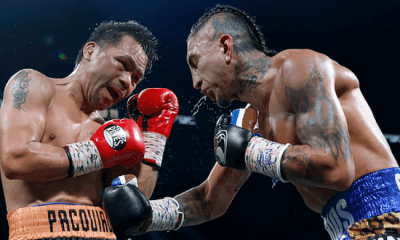
 Featured Articles2 weeks ago
Featured Articles2 weeks agoManny Pacquiao and Mario Barrios Fight to a Draw; Fundora stops Tim Tszyu
-

 Featured Articles3 weeks ago
Featured Articles3 weeks agoPhiladelphia Welterweight Gil Turner, a Phenom, Now Rests in an Unmarked Grave
-
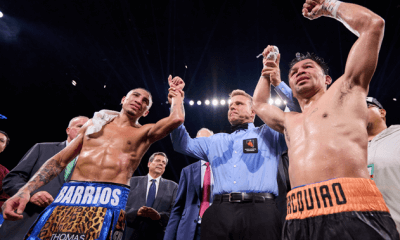
 Featured Articles2 weeks ago
Featured Articles2 weeks agoArne’s Almanac: Pacquiao-Barrios Redux
-

 Featured Articles4 weeks ago
Featured Articles4 weeks agoCatterall vs Eubank Ends Prematurely; Catterall Wins a Technical Decision


